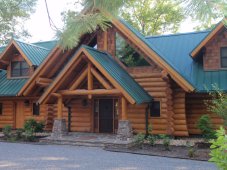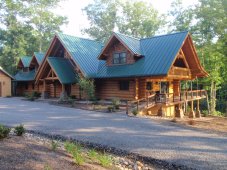MarkBorgen
New Member
I have a very unique need for solar panels, inverter(s) and batteries. They will most likely not be coming in the 'normal' sequence. This will be a longer initial post than most, so I will beg your indulgences in advance.
I've been designing and building handcrafted log homes for over 50 years and I just bought a farm in Sweden. I'm in the process of moving and I am working on a hybrid Swedish/American power system. A bit of background is needed so you can 'feel my pain.' US and Swedish (also most of Europe) power systems are different. The US power system at most homes and farms is basically 2 phase (120 v./120 v.) 60 Hz. power. We refer to things as 120 and 240 volt items and most house are set up this way. You can think of it as 1 Ph. and 2 Ph. power. In the US you would not need 3 Ph. until you approach a light industrial situation where some things are best run on 3 Ph. would you need any more than the two legs of 120/60 Hz. power. The Swedish system is different in that 99.9% of all homes and business have 3 Ph. (120 v./120 v./120 v.) but it is 50 Hz. Only the items with a very small current draw such as lamps, clocks, computers, televisions and such use one leg of the three available. In Sweden, most larger items such as microwaves, refrigerators, hair dryers and almost every smaller shop tool I own, which is a lot, are all run on 240 volt/50 Hz. All the heavy equipment that I own is 3 phase/60 Hz. These are things like my large air compressor, table saws, bandsaw, sand blasting booth and molding machine. These will all run on the Swedish 3Ph/50 Hz., but the RPM may vary a bit and I can adapt these. These are also easy to repower with Swedish motors over time if it is a problem.
My major need is for a system to cover me with 120/60 Hz. power for my shop. I have 50-60 tools and small equipment that require 120/60 Hz. US current. What I came up with first was taking a US solar inverter system with me and setting up a battery bank. I plan to use solar in the future, but I need the 120/60 Hz. immediately. For now I can charge the batteries with a 240/50 Hz. Swedish trickle charger and then convert it to 120/60 Hz. with the US inverter. The sense of dread has gone. I now know I can do this without having to sell all my 'well trained tools' for a dime on the dollar and then buying all new tools when I get to Sweden. I have better things to spend my money on.
Here is where I could use the help from the forum. I want to design the system so that I can get up and running quickly. I then want to add solar panels in the future as the time and money arrive. I do have a great solar site and several ways to mount a panel system and keep all parts in a fairly close area. There are at least two other considerations. We do have a fairly long winter and we do get some sub zero temperatures. The farm is located at 62.00700001068774°, 16.94538484907364° north latitude, west longitude. If you're familiar with Alaska, I would be about 10 miles south of Talkeetna on the way to Fairbanks. That makes for long days in the summer with the sun high and short days with the sun low in the winter. My site is a bit blessed with a climate that is more like north eastern Washington and Northern Idaho. I've attached a .pdf file showing the layout of the farmstead to give you an idea of where I am located.
So there it is. If you made it this far, I am interested in suggestions of building a suitable battery bank that I can get going quickly while designing it so that I am not wasting time and money to add solar panels later. I can also send excess power back into the grid. I look forward to getting a conversation rolling to see where it goes. Thanks/Tack så mycket, Mark.


I've been designing and building handcrafted log homes for over 50 years and I just bought a farm in Sweden. I'm in the process of moving and I am working on a hybrid Swedish/American power system. A bit of background is needed so you can 'feel my pain.' US and Swedish (also most of Europe) power systems are different. The US power system at most homes and farms is basically 2 phase (120 v./120 v.) 60 Hz. power. We refer to things as 120 and 240 volt items and most house are set up this way. You can think of it as 1 Ph. and 2 Ph. power. In the US you would not need 3 Ph. until you approach a light industrial situation where some things are best run on 3 Ph. would you need any more than the two legs of 120/60 Hz. power. The Swedish system is different in that 99.9% of all homes and business have 3 Ph. (120 v./120 v./120 v.) but it is 50 Hz. Only the items with a very small current draw such as lamps, clocks, computers, televisions and such use one leg of the three available. In Sweden, most larger items such as microwaves, refrigerators, hair dryers and almost every smaller shop tool I own, which is a lot, are all run on 240 volt/50 Hz. All the heavy equipment that I own is 3 phase/60 Hz. These are things like my large air compressor, table saws, bandsaw, sand blasting booth and molding machine. These will all run on the Swedish 3Ph/50 Hz., but the RPM may vary a bit and I can adapt these. These are also easy to repower with Swedish motors over time if it is a problem.
My major need is for a system to cover me with 120/60 Hz. power for my shop. I have 50-60 tools and small equipment that require 120/60 Hz. US current. What I came up with first was taking a US solar inverter system with me and setting up a battery bank. I plan to use solar in the future, but I need the 120/60 Hz. immediately. For now I can charge the batteries with a 240/50 Hz. Swedish trickle charger and then convert it to 120/60 Hz. with the US inverter. The sense of dread has gone. I now know I can do this without having to sell all my 'well trained tools' for a dime on the dollar and then buying all new tools when I get to Sweden. I have better things to spend my money on.
Here is where I could use the help from the forum. I want to design the system so that I can get up and running quickly. I then want to add solar panels in the future as the time and money arrive. I do have a great solar site and several ways to mount a panel system and keep all parts in a fairly close area. There are at least two other considerations. We do have a fairly long winter and we do get some sub zero temperatures. The farm is located at 62.00700001068774°, 16.94538484907364° north latitude, west longitude. If you're familiar with Alaska, I would be about 10 miles south of Talkeetna on the way to Fairbanks. That makes for long days in the summer with the sun high and short days with the sun low in the winter. My site is a bit blessed with a climate that is more like north eastern Washington and Northern Idaho. I've attached a .pdf file showing the layout of the farmstead to give you an idea of where I am located.
So there it is. If you made it this far, I am interested in suggestions of building a suitable battery bank that I can get going quickly while designing it so that I am not wasting time and money to add solar panels later. I can also send excess power back into the grid. I look forward to getting a conversation rolling to see where it goes. Thanks/Tack så mycket, Mark.







